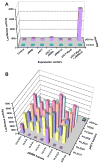Transcription variants of the prostate-specific PrLZ gene and their interaction with 14-3-3 proteins
- PMID: 19732746
- PMCID: PMC3311924
- DOI: 10.1016/j.bbrc.2009.08.165
Transcription variants of the prostate-specific PrLZ gene and their interaction with 14-3-3 proteins
Abstract
We have reported isolation and characterization of the prostate-specific and androgen-regulated PrLZ gene abnormally expressed in prostate cancer. PrLZ is a potential biomarker for prostate cancer and a candidate oncogene promoting cell proliferation and survival in prostate cancer cells. A full delineation of the PrLZ gene and its gene products may provide clues to the mechanisms regulating its expression and function. In this report, we identified three additional exons in the PrLZ gene and recognized five transcript variants from alternative splicing that could be detected by RT-PCR and Western blotting. Structural comparison demonstrated that the PrLZ proteins are highly conserved among species. PrLZ contains multiple potential sites for interaction with other proteins. We used mammalian two-hybrid assays to demonstrate that PrLZ isoforms interact with 14-3-3 proteins, and multiple sites in the PrLZ may be involved in the interaction. Alternative splicing may contribute to abnormally enhanced PrLZ levels in prostate cancer, and interaction with 14-3-3 proteins may be a mechanism by which PrLZ promotes cell proliferation and survival during prostate cancer development and progression. This information is a valuable addition to the investigation of the oncogenic properties of the PrLZ gene.
Figures




Similar articles
-
PrLZ protects prostate cancer cells from apoptosis induced by androgen deprivation via the activation of Stat3/Bcl-2 pathway.Cancer Res. 2011 Mar 15;71(6):2193-202. doi: 10.1158/0008-5472.CAN-10-1791. Epub 2011 Mar 8. Cancer Res. 2011. PMID: 21385902 Free PMC article.
-
PrLZ is expressed in normal prostate development and in human prostate cancer progression.Clin Cancer Res. 2007 Oct 15;13(20):6040-8. doi: 10.1158/1078-0432.CCR-07-0640. Clin Cancer Res. 2007. PMID: 17947466
-
PrLZ expression is associated with the progression of prostate cancer LNCaP cells.Mol Carcinog. 2009 May;48(5):432-40. doi: 10.1002/mc.20481. Mol Carcinog. 2009. PMID: 18800346
-
Androgen receptors in early and castration resistant prostate cancer: friend or foe?Hormones (Athens). 2013 Apr-Jun;12(2):224-35. doi: 10.14310/horm.2002.1406. Hormones (Athens). 2013. PMID: 23933691 Review. No abstract available.
-
RNA splicing and splicing regulator changes in prostate cancer pathology.Hum Genet. 2017 Sep;136(9):1143-1154. doi: 10.1007/s00439-017-1792-9. Epub 2017 Apr 5. Hum Genet. 2017. PMID: 28382513 Free PMC article. Review.
Cited by
-
Increased PrLZ-mediated androgen receptor transactivation promotes prostate cancer growth at castration-resistant stage.Carcinogenesis. 2013 Feb;34(2):257-67. doi: 10.1093/carcin/bgs337. Epub 2012 Oct 26. Carcinogenesis. 2013. PMID: 23104178 Free PMC article.
-
DNA methylome changes by estradiol benzoate and bisphenol A links early-life environmental exposures to prostate cancer risk.Epigenetics. 2016 Sep;11(9):674-689. doi: 10.1080/15592294.2016.1208891. Epub 2016 Jul 14. Epigenetics. 2016. PMID: 27415467 Free PMC article.
-
Isoform 1 of TPD52 (PC-1) promotes neuroendocrine transdifferentiation in prostate cancer cells.Tumour Biol. 2016 Aug;37(8):10435-46. doi: 10.1007/s13277-016-4925-1. Epub 2016 Feb 5. Tumour Biol. 2016. PMID: 26846108
-
Tumor protein D54 is a negative regulator of extracellular matrix-dependent migration and attachment in oral squamous cell carcinoma-derived cell lines.Cell Oncol (Dordr). 2013 Jun;36(3):233-45. doi: 10.1007/s13402-013-0131-y. Epub 2013 Mar 26. Cell Oncol (Dordr). 2013. PMID: 23529586
-
PC-1/PrLZ confers resistance to rapamycin in prostate cancer cells through increased 4E-BP1 stability.Oncotarget. 2015 Aug 21;6(24):20356-69. doi: 10.18632/oncotarget.3931. Oncotarget. 2015. PMID: 26011939 Free PMC article.
References
-
- Eder IE, Bektic J, Haag P, Bartsch G, Klocker H. Genes differentially expressed in prostate cancer. BJU Int. 2004;93:1151–5. - PubMed
-
- Gelmann EP, Semmes OJ. Expression of genes and proteins specific for prostate cancer. J Urol. 2004;172:S23-6. discussion S26-7. - PubMed
-
- Myers RB, Grizzle WE. Changes in biomarker expression in the development of prostatic adenocarcinoma. Biotech Histochem. 1997;72:86–95. - PubMed
-
- Petrovics G, Zhang W, Makarem M, Street JP, Connelly R, Sun L, Sesterhenn IA, Srikantan V, Moul JW, Srivastava S. Elevated expression of PCGEM1, a prostate-specific gene with cell growth-promoting function, is associated with high-risk prostate cancer patients. Oncogene. 2004;23:605–11. - PubMed
-
- Wang R, Xu J, Mabjeesh N, Zhu G, Zhou J, Amin M, He D, Marshall FF, Zhau HE, Chung LW. PrLZ is expressed in normal prostate development and in human prostate cancer progression. Clin Cancer Res. 2007;13:6040–8. - PubMed
Publication types
MeSH terms
Substances
Grants and funding
LinkOut - more resources
Full Text Sources
Medical
Molecular Biology Databases

